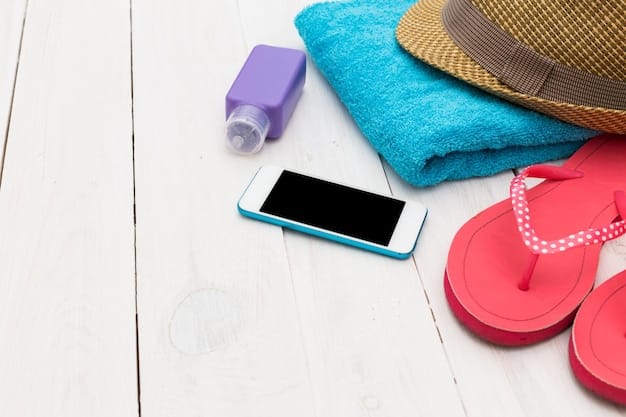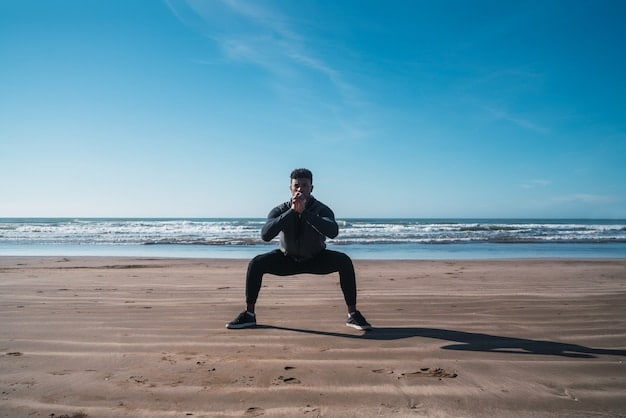Beach Workout: Your Guide to Staying Fit on Vacation

Beach workout offers a refreshing way to maintain your fitness routine while enjoying your vacation; discover effective exercises, safety tips, and motivational strategies for staying active on the sand.
Planning a vacation doesn’t mean hitting pause on your fitness goals. A beach workout is the perfect way to stay active, soak up the sun, and enjoy the beautiful scenery.
Why Choose a Beach Workout?
Working out on the beach offers a unique and invigorating experience compared to traditional gyms. The natural environment provides numerous physical and mental benefits, making it an ideal choice for staying fit during your vacation. Let’s explore some of the top reasons why a beach workout is a fantastic option.
Benefits of Exercising on Sand
Sand provides an unstable surface that forces your muscles to work harder, leading to increased calorie burn and improved strength. This natural resistance can enhance your workout in several ways:
- Increased Muscle Activation: The uneven surface activates more muscles, especially in your legs and core, to maintain balance and stability.
- Calorie Burn: Exercising on sand can burn up to 50% more calories compared to working out on a solid surface.
- Low Impact: Sand offers a softer landing, reducing the impact on your joints and making it a great option for people with joint pain or injuries.
Mental Health Benefits
Beyond the physical advantages, beach workouts offer significant mental health benefits. The combination of fresh air, sunshine, and the sound of the ocean can reduce stress and improve your overall mood.
Studies have shown that spending time in nature can lower cortisol levels (the stress hormone) and increase feelings of relaxation and well-being. A beach workout allows you to connect with nature while taking care of your body.
In summary, choosing a beach workout offers a unique blend of physical challenges and mental relaxation. The benefits of exercising on sand, combined with the soothing environment, make it a worthwhile addition to your vacation routine.
Essential Equipment for Your Beach Workout
While the beach itself provides a fantastic workout environment, having the right equipment can enhance your experience and ensure you get the most out of your session. Here’s a list of essential items to consider bringing to your beach workout:
Although you can use the beach as your gym, having the correct gear will significantly impact your performance.
- Water Bottle: Staying hydrated is crucial, especially in the sun. Carry a reusable water bottle to keep cool and refreshed.
- Sunscreen: Protect your skin from harmful UV rays with a high SPF sunscreen, even on cloudy days.
- Towel: A quick-drying towel is essential for wiping off sweat and sand.
- Workout Clothes: Opt for lightweight, breathable fabrics that wick away moisture and allow for easy movement.

Optional Equipment
Depending on your fitness goals and preferences, you might want to include additional equipment to diversify your workout routine.
- Resistance Bands: Lightweight and versatile, resistance bands can add intensity to your exercises and target specific muscle groups.
- Jump Rope: A jump rope is a great tool for cardio and coordination.
- Yoga Mat: If you plan to incorporate yoga or stretching, a yoga mat provides a comfortable and clean surface.
Remember to pack your equipment carefully to avoid any damage during transportation. A well-prepared workout session ensures you can focus on your fitness goals without any unnecessary interruptions.
Effective Beach Exercises
Now that you’re equipped and ready, let’s dive into some effective exercises you can perform on the beach. These exercises target various muscle groups and can be modified to suit different fitness levels. Let’s explore a range of exercises that use the beach environment to your advantage.
Cardio Exercises
Cardio exercises get your heart pumping and help you burn calories. The sand provides extra resistance, making these activities more challenging and effective.
- Beach Sprints: Sprinting on sand engages more muscles than running on a flat surface, improving speed and power.
- Beach Jogging: A steady-paced jog along the shoreline is a great way to warm up and improve endurance.
- Jumping Jacks: Perform jumping jacks on the sand for a full-body cardio workout that improves coordination and agility.

Strength Training Exercises
Strength training exercises help build muscle and improve overall strength. The sand’s instability forces your muscles to work harder, enhancing the benefits of these exercises.
- Beach Lunges: Lunges on sand engage your quads, glutes, and hamstrings, improving lower body strength and stability.
- Push-Ups: Perform push-ups on a slightly inclined surface to challenge your chest, shoulders, and triceps.
- Squats: Squats on sand improve lower body strength and balance. Ensure proper form to avoid injuries.
Core Strengthening Exercises
A strong core is essential for stability and balance. These exercises target your abdominal and back muscles, helping to improve posture and prevent injuries.
- Plank: Hold a plank position on the sand to engage your core muscles and improve stability.
- Crunches: Perform crunches on the beach to target your abdominal muscles and improve core strength.
- Russian Twists: Sit on the sand with your knees bent and twist your torso from side to side, engaging your obliques and core.
Incorporating a mix of cardio, strength training, and core exercises into your beach workout routine will ensure a well-rounded and effective fitness session.
Staying Safe During Your Beach Workout
While a beach workout can be incredibly rewarding, it’s essential to prioritize your safety to avoid injuries and health issues. Let’s focus on several safety tips to ensure a safe and enjoyable workout experience.
Hydration and Sun Protection
Staying hydrated and protecting yourself from the sun are crucial aspects of beach workout safety. Dehydration and sunburn can lead to serious health problems, so take the necessary precautions.
Drink plenty of water before, during, and after your workout to stay hydrated. Avoid sugary drinks, as they can dehydrate you. Apply a broad-spectrum sunscreen with an SPF of 30 or higher to all exposed skin areas. Reapply every two hours, especially after swimming or sweating.
Wear sunglasses to protect your eyes from the sun’s glare. Consider wearing a hat to shield your face and neck from harmful UV rays.
Warm-Up and Cool-Down
A proper warm-up and cool-down are essential for preventing injuries and reducing muscle soreness. Before starting your workout, perform dynamic stretches like arm circles, leg swings, and torso twists to prepare your muscles for exertion.
After your workout, cool down with static stretches, holding each stretch for 20-30 seconds. Focus on stretching the muscles you used during your workout, such as your quads, hamstrings, and calves.
Avoid pushing yourself too hard, especially when starting a new workout routine. Listen to your body and take breaks when needed.
Motivating Yourself for a Beach Workout
Staying motivated to exercise can be challenging, but the beach offers a unique and inspiring environment that can help you stick to your fitness goals. Let’s explore strategies to stay motivated and make the most of your beach workout experience.
Set Realistic Goals
Start by setting achievable goals that align with your fitness level and preferences. Whether it’s walking for 30 minutes, jogging for a mile, or completing a set of strength training exercises, having clear goals will keep you focused and motivated.
- Small, Achievable Steps: Instead of aiming for a drastic change, break down your goals into smaller, manageable steps.
- Track Your Progress: Keep a record of your workouts, noting the exercises you completed, the duration, and any personal bests.
Find a Workout Buddy
Working out with a friend can make your beach workout more enjoyable and help you stay accountable. A workout buddy can provide encouragement, support, and motivation when you need it most.
Plan regular workout sessions with your buddy and set shared fitness goals. Make your beach workout a social event, combining exercise with conversation and laughter.
Visualizing your success can boost your confidence and motivation. Imagine yourself reaching your fitness goals, feeling stronger, healthier, and more energized.
Sample Beach Workout Routine
To help you get started, here’s a sample 30-minute beach workout routine that combines cardio, strength training, and core exercises. Remember to adjust the intensity and duration of each exercise to suit your fitness level.
- Warm-Up (5 minutes): Begin with light cardio, such as jogging or jumping jacks, to warm up your muscles.
- Cardio (10 minutes): Perform beach sprints, alternating between sprinting and walking for recovery.
- Strength Training (10 minutes): Complete three sets of the following exercises:
- Cool-Down (5 minutes): Finish with static stretches, holding each stretch for 20-30 seconds.
This routine is just a starting point, and you can customize it to fit your preferences and fitness goals. Experiment with different exercises and variations to keep your beach workout fresh and exciting.
| Key Point | Brief Description |
|---|---|
| 💪 Exercise Variety | Combine cardio, strength, and core exercises for a full-body workout on the beach. |
| 🧴 Sun Protection | Use sunscreen, sunglasses, and a hat to protect from harmful UV rays during your beach workout. |
| 💧 Hydration | Stay hydrated by drinking plenty of water before, during, and after your workout. |
| 🏖️ Beach Benefits | Enjoy increased calorie burn and mental relaxation from natural resistance and soothing environment. |
Frequently Asked Questions (FAQs)
▼
Great exercises include beach sprints, lunges, squats, push-ups, planks, and Russian twists. Mix cardio, strength training, and core exercises for a well-rounded routine targeting various muscle groups.
▼
Drink plenty of water before, during, and after your workout. Avoid sugary drinks as they can dehydrate you. Carry a reusable water bottle and sip water regularly, especially in hot weather.
▼
Protect your skin with sunscreen, wear sunglasses, and stay hydrated. Warm-up before exercising to prevent injuries and cool down afterward. Listen to your body and avoid overexertion in extreme heat or conditions.
▼
Set realistic, achievable goals and track your progress. Find a workout buddy for support and accountability. Vary your routine to keep it engaging. Visualize success to stay focused and committed to your goals.
▼
Essential items include water, sunscreen, a towel, and workout clothes. Optional equipment might be resistance bands, a jump rope, or a yoga mat. Pack to enhance comfort, safety, and effectiveness on the sand.
Conclusion
Incorporating a beach workout into your vacation is an excellent way to stay fit, healthy, and energized while enjoying the beauty of the coast. By following these tips and developing a routine that suits your fitness level, you can make the most of your beach vacation and return home feeling rejuvenated.





